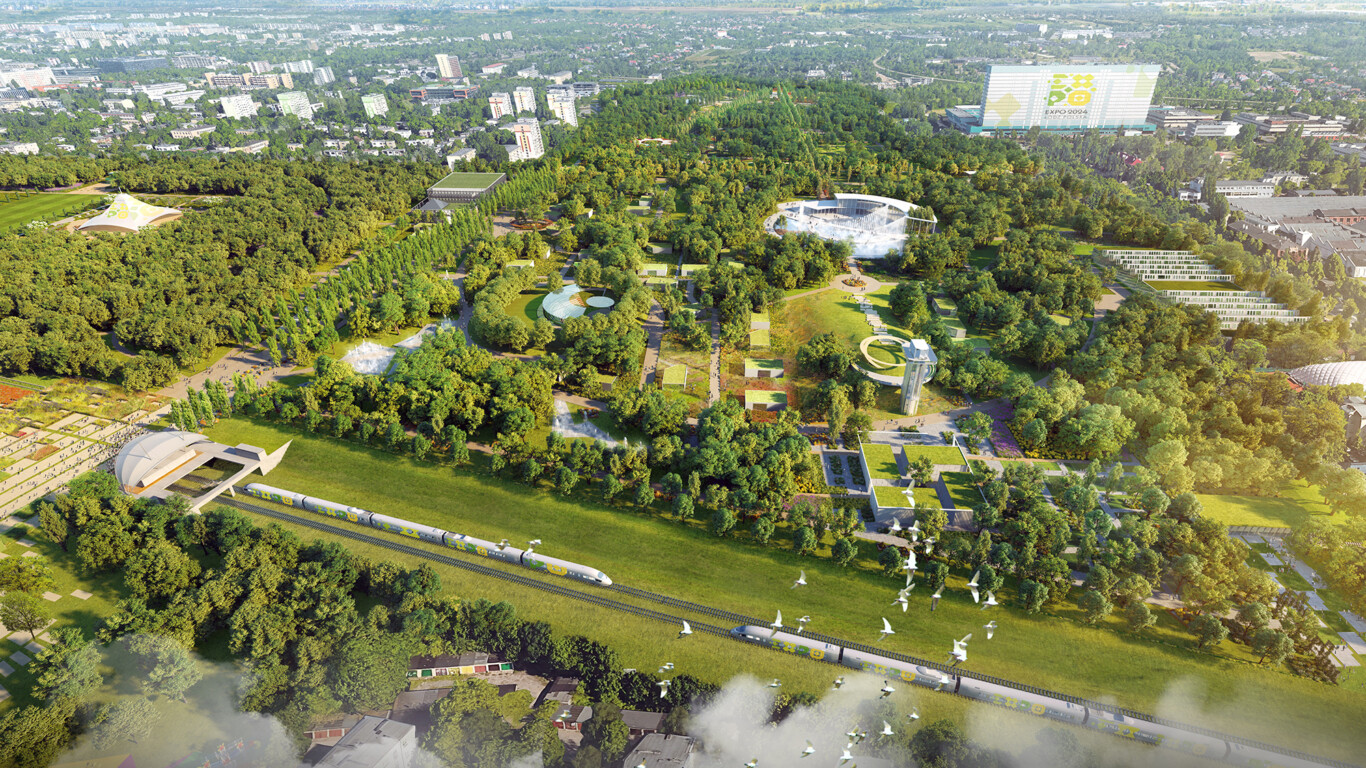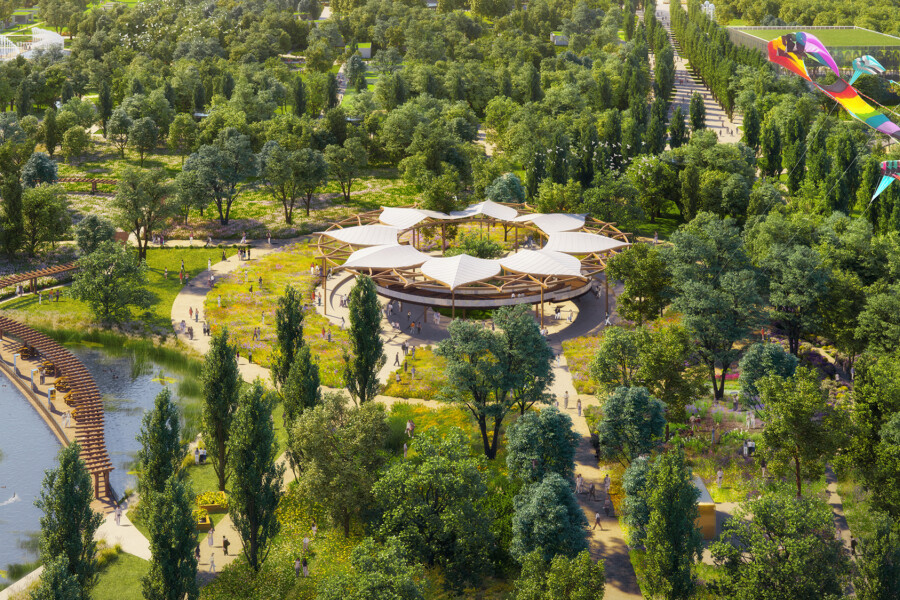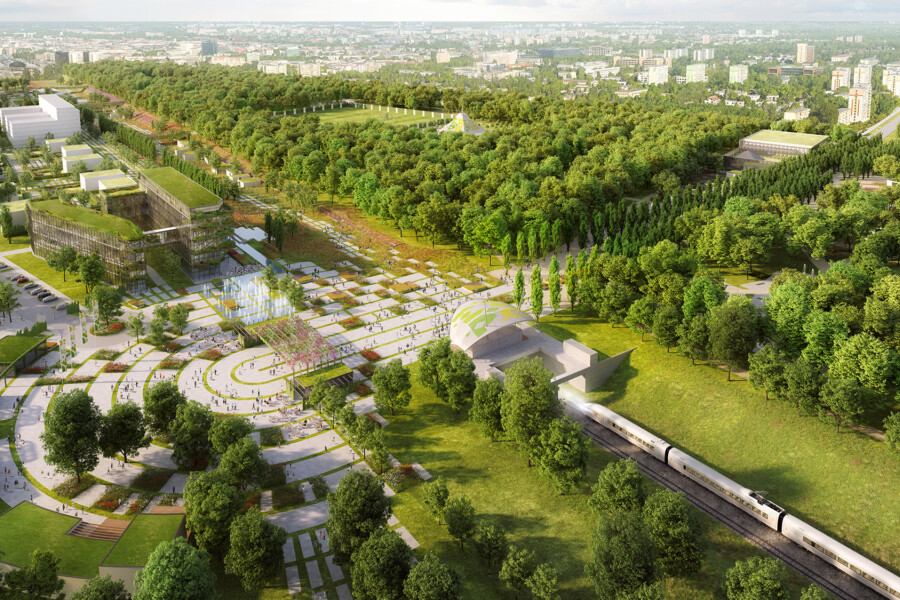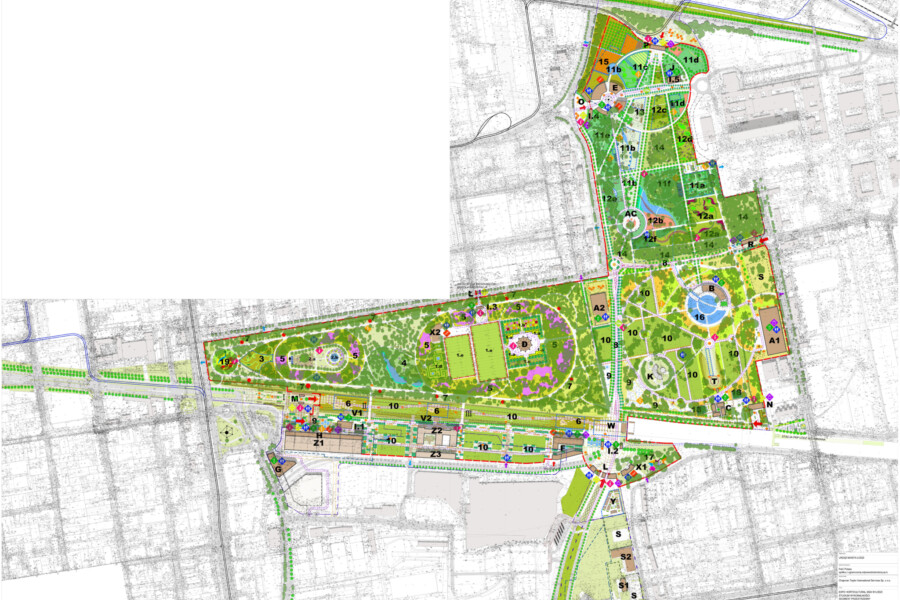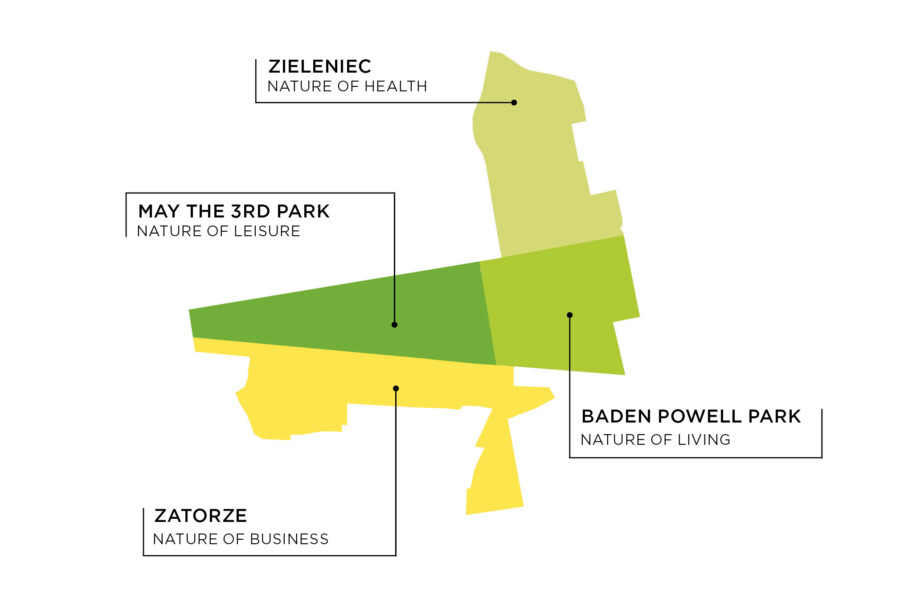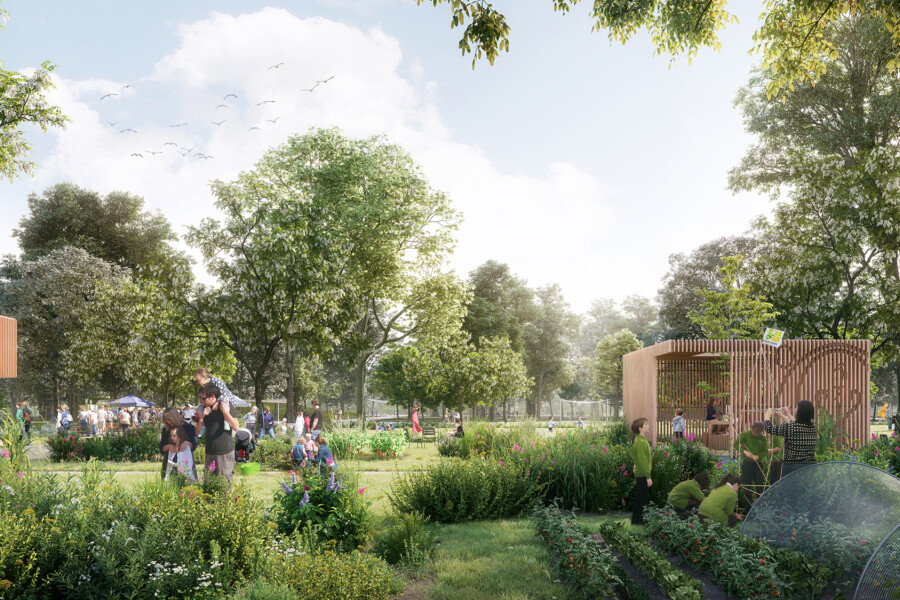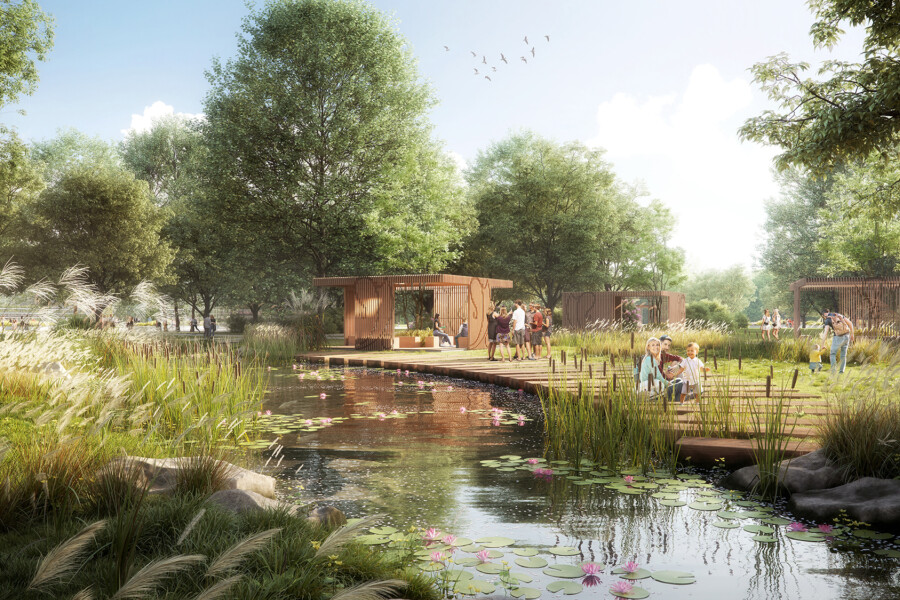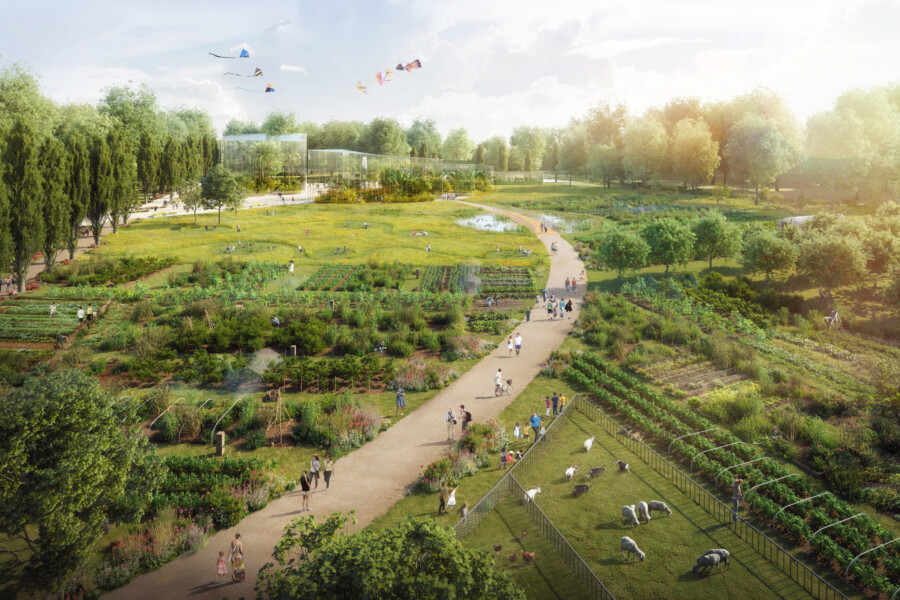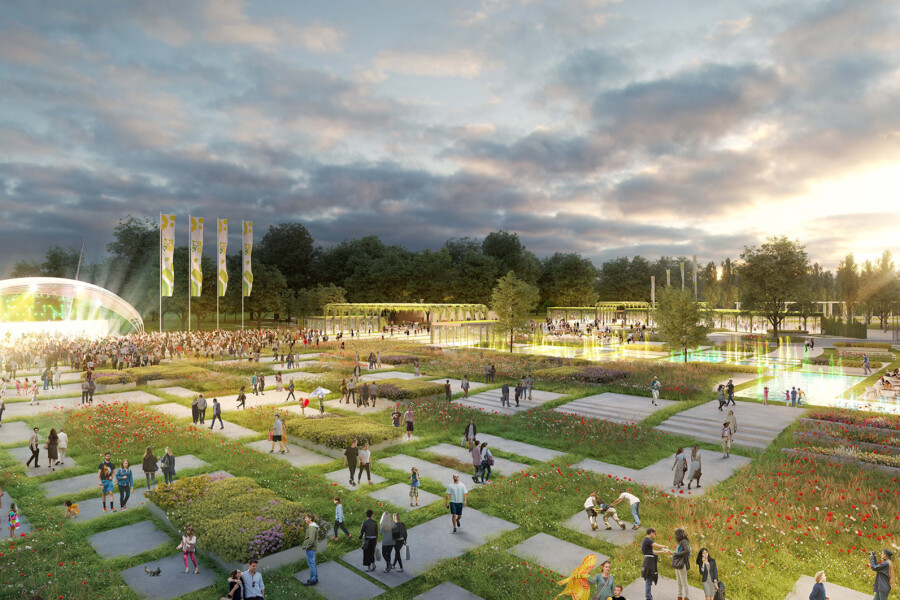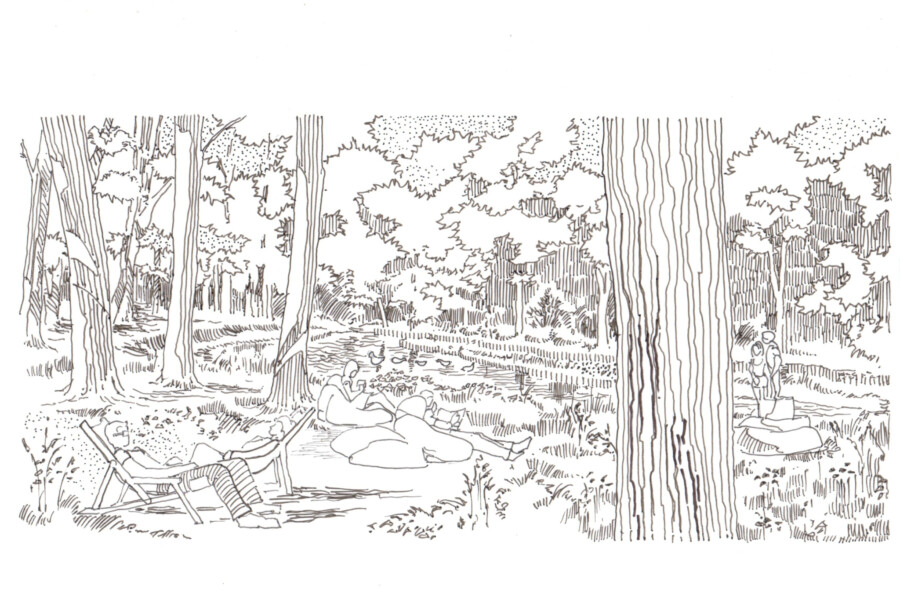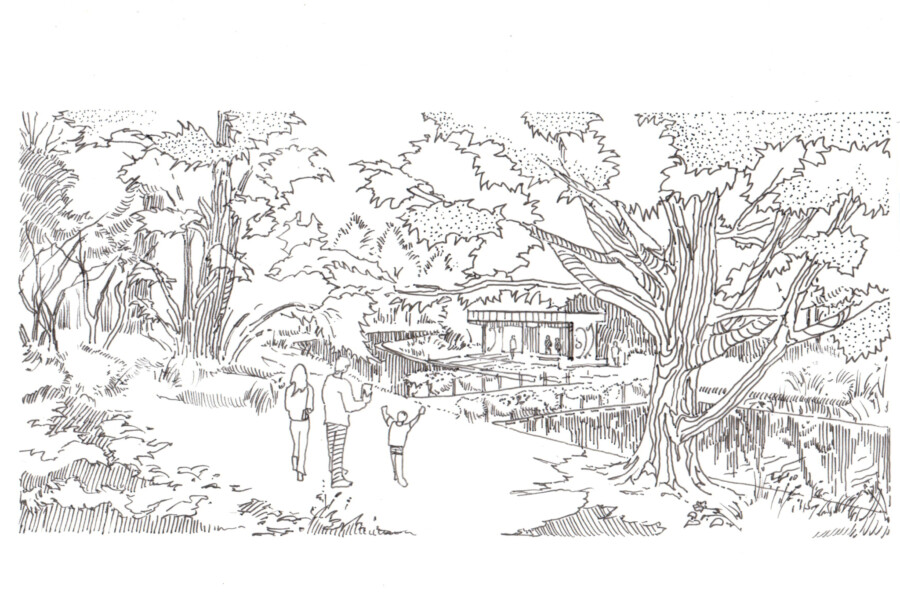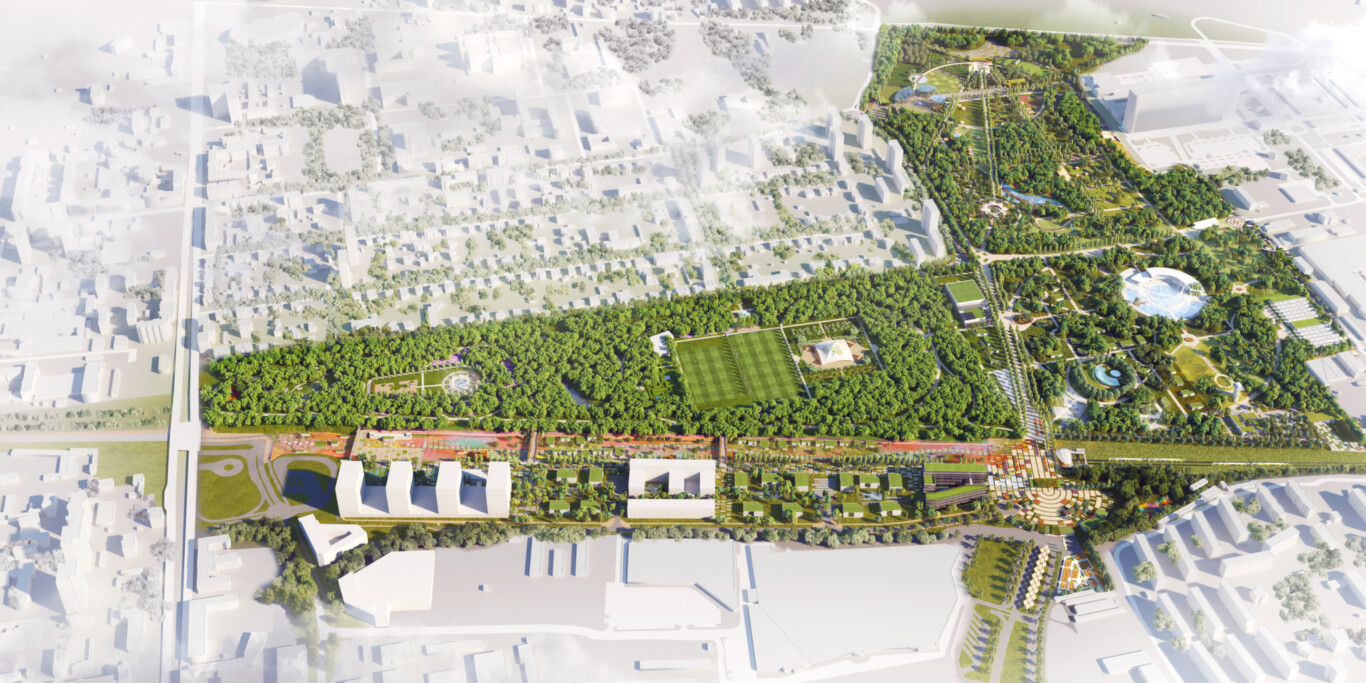
Project Profile: Designing World Horticultural Expo Łódź to provide a lasting urban legacy
In 2018, the city of Łódź, in central Poland, was named as the site of World Horticultural EXPO (also known as Green EXPO) for 2024. World Horticultural EXPO is an international exhibition devoted to the use of greenery and landscaping in urban environments. The 80-hectare project is the first of its kind because, whereas all previous World Horticultural EXPO developments were created in remote, undeveloped areas, in Łódź it is located in the heart of the city centre, not far from the main railway station and surrounded by urban fabric.
Chapman Taylor was awarded the public tender to create the Łódź EXPO masterplan concept in December 2018. A 30-strong multidisciplinary team worked intensively under the direction of Associate Director Mariusz Wróblewski, in collaboration with the City and other stakeholders, to deliver the innovative design in December 2019. In this project profile, Mariusz tells us about the key themes and principles behind Chapman Taylor’s concept and the importance of ensuring a positive long-term urban legacy for the city after EXPO ends.
Tell us about the project and Chapman Taylor’s involvement in it.
World Horticultural EXPO, often called “Green EXPO”, is focused on creating new green spaces and recreational areas in the cities around the world which host the event. In March 2018, the city of Łódź in central Poland was awarded World Horticultural EXPO for 2024 (although this has now been postponed to 2029 as a result of the COVID-19 pandemic).
The focus of the EXPO event in Łódź is to improve the quality of life for citizens who live and spend time there through a sustainable and technologically advanced development which respects the area’s history, architecture and traditions.
Chapman Taylor, alongside PWC, was invited by the City of Łódź to create a feasibility study of the complex project and to produce recommendations on how to best organise and deliver the exhibition successfully. The feasibility study consisted of seven segments:
· Location
· Programme
· Spatial strategy
· Transportation
· Budget and organisation
· Supporting areas
· Supplementary analysis.
Which segments did your studio work on?
Chapman Taylor was responsible for the location segment, with spatial, environmental, industrial, technical, organisational, socio-economic and transportation analysis of the chosen exhibition sites. We produced a geographical and natural inventory, including identifying 18,000 trees, as well as conducting research on the water supply and archival inquiries.
We were also responsible for the spatial strategy, developing four concept options for the masterplan and a detailed plan for the spatial and functional development of the exhibition area, including after EXPO concludes. This process included producing a list of supporting functions and defining their optimum distribution, a description and schedule of greenery, provision for media
coverage and an analysis of investment requirements. The masterplan was developed taking account of the latest technological and functional approaches, such as Smart City and Green City solutions.
For the transportation segment, we analysed the existing transport provisions for the exhibition area and its adjacencies, and we produced recommendations for new transport options and operational solutions for inside the exhibition area.
The other segment we worked on was for the supporting areas, for which we produced a general concept for tourism routes through green areas such as parks, sports facilities and attractive public spaces, including areas beside key historical buildings.
What was the thinking behind Chapman Taylor’s concept design for World Horticultural EXPO Łódź?
Our masterplan concept was focused on two general goals – a successful EXPO and an enduring post-EXPO legacy. It developed from a preliminary workshop with the client, where we discussed the main assumptions behind the project, existing local conditions and key stakeholders. We developed a schedule for the whole design process and planned regular meetings with the relevant City departments and other relevant participants.
The main theme behind the concept is “Nature of the City”, with an emphasis on the importance of green spaces in the city and the role of a reshaped urban landscape in regenerating the city. Ecological renewal, environmental sustainability and technological solutions were placed at the heart of the design agenda.
In the first phase of the project, I used hand sketching as a tool for providing analysis of the city’s identity. I drew sketches of various historical buildings in the city, including apartment houses, palaces, industrial buildings and factories, making sure to capture their detailing. This proved to be very helpful when we talked to representatives from the City’s architects, who became very friendly and receptive to our ideas because they, as architects, appreciated the use of sketching in this way.
When we began work on the masterplan, I drew sketches using a tablet because it was the fastest way to produce a good result and the process of correcting was simple, meaning I didn’t have to redraw many elements. It was a very efficient way of visualising and communicating the assumptions behind the project.
Was the development of the concept's themes a collaborative process?
Very much so. The “Nature of the City” theme behind the masterplan concept is an umbrella for five sub-themes. The masterplan’s functions are arranged around four themed zones, each created in spaces with distinct and unique characters, and these were developed in consultation with the city and more than 50 other organisations:
• Nature of Leisure – the historic May the 3rd Park represents forest and lake exploration, offering family recreation as well as sport and fitness options for people of all ages.
• Nature of Living – the modern Baden Powell Park will host the main EXPO programme, including the Polish Pavilion, the City of Łódź Pavilion surrounded by Gardens of Four Cultures, the international participants’ National Gardens, an amphitheatre, a viewing tower and exhibition halls.
• Nature of Health – the wilder Zieleniec area includes environmentally friendly design solutions combined with EcoUMed Health Academy’s horti-therapy programme, Gardens of Healthy Food, Clean Air and Water, Gardens of Senses and the Circular Village.
• Nature of Business – the post-industrial Zatorze area is perfect for hosting business conferences, seminars, science meetings and business networking.
In addition, an overall “Nature of Us” theme combines elements of all the others to reflect a modern city that provides employment, facilitates rest and recharging in green surroundings, showcases cultural diversity and provides daily close contact with the environment. This will be the connecting link between the four main areas.
We developed four options based on the above themes in consultation with the City and the City’s architects, one of which was selected for further development into five further versions, from which the final option was chosen collaboratively. We made multiple presentations to representatives of the City during the design’s development, but also to many stakeholders, in recognition of the fact that EXPO will have a major impact on local communities.
We also conducted two research walks around the exhibition area to explain our ideas to the people of Łódź, including showing them the environmental conditions and outlining the spatial assumptions. More than 200 people took part in those walks, while over 3,000 people were involved in our combined participatory initiatives.
What were the challenges of creating the concept for an existing urban site and incorporating existing parks and buildings?
Previous World Horticultural EXPO developments were created in remote, undeveloped areas but, in Łódź, it is located in the city centre, near the railway station and medical university and surrounded by urban fabric. It is not densely built up, as the site includes two existing parks, but it is certainly the first substantially urban World Horticultural EXPO event.
The main challenges included the need to revitalise the historic May the 3rd park and to preserve the existing greenery. About 100,000 new plants will be put in, including more than 1,000 new trees. The unique characters of the spaces gave us inspiration and helped us to identify ways to correct problems and give those spaces a new purpose and identity.
Pinpointing a suitable location for the proposed National Gardens was a key challenge also, because of the need to provide space for pavilions. We decided to place the pavilions just outside the parks, above the railway tunnel and in the post-industrial areas to the south, leaving space in Baden Powell Park for the National Gardens.
Tell us about the emphasis on recycling, regenerating and reusing.
The core of the brief for this project was ecological and environmental sustainability, and that mission manifests itself in several ways. For example, we use the natural environment as an asset for achieving energy efficiency, such as employing the wind for ventilation. Among the main strategies we adopt to ensure environmental sustainability on the EXPO project are ground-source heat pumps, solar water heating, photovoltaic panels, water retention and greywater purification and green roofs.
Architecture should always take account of the need to sustainably optimise elements such as energy efficiency, water preservation, construction processes, materials and the operation of the buildings.
The exhibition area forms part of the of wider ecological system of Łódź, described in the project as the “Blue-Green Network” - a spatial development strategy connecting the city with its green surroundings, natural parks and forests, rivers, water reservoirs, swimming pools, sports and recreation facilities and trails. Various elements of the Blue-Green infrastucture at the EXPO development will be presented at EXPO itself as the basis for the long-term ecological strategy for the whole city.
What will be the post-EXPO legacy, in terms of repurposing the EXPO site as part of the city's long-term development strategy? After EXPO completes, some facilities will remain, while others will be converted to new uses such as permanent exposition spaces as well as business and administration, cultural, educational, healthcare, sport and leisure, recreational and gastronomic facilities – all within a mostly retained and carefully maintained, landscaped green environment. Some pavilions, structures and installations will be moved to other locations within the city, mainly in its public green areas, parks and squares.
The amphitheatre in Baden Powell Park will be modernised as a cultural and entertainment venue for the city. The Polish Pavilion will turn into a cultural and educational facility, while the City of Łódź Pavilion will be a venue for cultural events. The greenhouse for urban crops will continue to serve residents of the city, while the multifunctional building in Zatorze will be home to a biodiversity centre, offices and an exhibition area. Water features such as fountains, resevoirs, rainwater retention facilities and irrigation infrastructure will remain in place.
Horticultural EXPO is a central part of the city’s longer-term development strategy – incorporating substantially more green space within the city’s urban fabric as an engine of urban regeneration, creating pocket gardens, woonerfs (living streets) and a network of over 120km of green trails as the core elements of the Blue-Green Network.
The City has expressed great satisfaction with our designs and vision for World Horticultural EXPO and its legacy, and we believe it will not just be a great event for Łódź, but also the basis for a sustainable reinvigoration of the city which will serve generations to come.
Tell us about the project and Chapman Taylor’s involvement in it.
World Horticultural EXPO, often called “Green EXPO”, is focused on creating new green spaces and recreational areas in the cities around the world which host the event. In March 2018, the city of Łódź in central Poland was awarded World Horticultural EXPO for 2024 (although this has now been postponed to 2029 as a result of the COVID-19 pandemic).
The focus of the EXPO event in Łódź is to improve the quality of life for citizens who live and spend time there through a sustainable and technologically advanced development which respects the area’s history, architecture and traditions.
Chapman Taylor, alongside PWC, was invited by the City of Łódź to create a feasibility study of the complex project and to produce recommendations on how to best organise and deliver the exhibition successfully. The feasibility study consisted of seven segments:
· Location
· Programme
· Spatial strategy
· Transportation
· Budget and organisation
· Supporting areas
· Supplementary analysis.
Which segments did your studio work on?
Chapman Taylor was responsible for the location segment, with spatial, environmental, industrial, technical, organisational, socio-economic and transportation analysis of the chosen exhibition sites. We produced a geographical and natural inventory, including identifying 18,000 trees, as well as conducting research on the water supply and archival inquiries.
We were also responsible for the spatial strategy, developing four concept options for the masterplan and a detailed plan for the spatial and functional development of the exhibition area, including after EXPO concludes. This process included producing a list of supporting functions and defining their optimum distribution, a description and schedule of greenery, provision for media
coverage and an analysis of investment requirements. The masterplan was developed taking account of the latest technological and functional approaches, such as Smart City and Green City solutions.
For the transportation segment, we analysed the existing transport provisions for the exhibition area and its adjacencies, and we produced recommendations for new transport options and operational solutions for inside the exhibition area.
The other segment we worked on was for the supporting areas, for which we produced a general concept for tourism routes through green areas such as parks, sports facilities and attractive public spaces, including areas beside key historical buildings.
What was the thinking behind Chapman Taylor’s concept design for World Horticultural EXPO Łódź?
Our masterplan concept was focused on two general goals – a successful EXPO and an enduring post-EXPO legacy. It developed from a preliminary workshop with the client, where we discussed the main assumptions behind the project, existing local conditions and key stakeholders. We developed a schedule for the whole design process and planned regular meetings with the relevant City departments and other relevant participants.
The main theme behind the concept is “Nature of the City”, with an emphasis on the importance of green spaces in the city and the role of a reshaped urban landscape in regenerating the city. Ecological renewal, environmental sustainability and technological solutions were placed at the heart of the design agenda.
In the first phase of the project, I used hand sketching as a tool for providing analysis of the city’s identity. I drew sketches of various historical buildings in the city, including apartment houses, palaces, industrial buildings and factories, making sure to capture their detailing. This proved to be very helpful when we talked to representatives from the City’s architects, who became very friendly and receptive to our ideas because they, as architects, appreciated the use of sketching in this way.
When we began work on the masterplan, I drew sketches using a tablet because it was the fastest way to produce a good result and the process of correcting was simple, meaning I didn’t have to redraw many elements. It was a very efficient way of visualising and communicating the assumptions behind the project.
Was the development of the concept's themes a collaborative process?
Very much so. The “Nature of the City” theme behind the masterplan concept is an umbrella for five sub-themes. The masterplan’s functions are arranged around four themed zones, each created in spaces with distinct and unique characters, and these were developed in consultation with the city and more than 50 other organisations:
• Nature of Leisure – the historic May the 3rd Park represents forest and lake exploration, offering family recreation as well as sport and fitness options for people of all ages.
• Nature of Living – the modern Baden Powell Park will host the main EXPO programme, including the Polish Pavilion, the City of Łódź Pavilion surrounded by Gardens of Four Cultures, the international participants’ National Gardens, an amphitheatre, a viewing tower and exhibition halls.
• Nature of Health – the wilder Zieleniec area includes environmentally friendly design solutions combined with EcoUMed Health Academy’s horti-therapy programme, Gardens of Healthy Food, Clean Air and Water, Gardens of Senses and the Circular Village.
• Nature of Business – the post-industrial Zatorze area is perfect for hosting business conferences, seminars, science meetings and business networking.
In addition, an overall “Nature of Us” theme combines elements of all the others to reflect a modern city that provides employment, facilitates rest and recharging in green surroundings, showcases cultural diversity and provides daily close contact with the environment. This will be the connecting link between the four main areas.
We developed four options based on the above themes in consultation with the City and the City’s architects, one of which was selected for further development into five further versions, from which the final option was chosen collaboratively. We made multiple presentations to representatives of the City during the design’s development, but also to many stakeholders, in recognition of the fact that EXPO will have a major impact on local communities.
We also conducted two research walks around the exhibition area to explain our ideas to the people of Łódź, including showing them the environmental conditions and outlining the spatial assumptions. More than 200 people took part in those walks, while over 3,000 people were involved in our combined participatory initiatives.
What were the challenges of creating the concept for an existing urban site and incorporating existing parks and buildings?
Previous World Horticultural EXPO developments were created in remote, undeveloped areas but, in Łódź, it is located in the city centre, near the railway station and medical university and surrounded by urban fabric. It is not densely built up, as the site includes two existing parks, but it is certainly the first substantially urban World Horticultural EXPO event.
The main challenges included the need to revitalise the historic May the 3rd park and to preserve the existing greenery. About 100,000 new plants will be put in, including more than 1,000 new trees. The unique characters of the spaces gave us inspiration and helped us to identify ways to correct problems and give those spaces a new purpose and identity.
Pinpointing a suitable location for the proposed National Gardens was a key challenge also, because of the need to provide space for pavilions. We decided to place the pavilions just outside the parks, above the railway tunnel and in the post-industrial areas to the south, leaving space in Baden Powell Park for the National Gardens.
Tell us about the emphasis on recycling, regenerating and reusing.
The core of the brief for this project was ecological and environmental sustainability, and that mission manifests itself in several ways. For example, we use the natural environment as an asset for achieving energy efficiency, such as employing the wind for ventilation. Among the main strategies we adopt to ensure environmental sustainability on the EXPO project are ground-source heat pumps, solar water heating, photovoltaic panels, water retention and greywater purification and green roofs.
Architecture should always take account of the need to sustainably optimise elements such as energy efficiency, water preservation, construction processes, materials and the operation of the buildings.
The exhibition area forms part of the of wider ecological system of Łódź, described in the project as the “Blue-Green Network” - a spatial development strategy connecting the city with its green surroundings, natural parks and forests, rivers, water reservoirs, swimming pools, sports and recreation facilities and trails. Various elements of the Blue-Green infrastucture at the EXPO development will be presented at EXPO itself as the basis for the long-term ecological strategy for the whole city.
What will be the post-EXPO legacy, in terms of repurposing the EXPO site as part of the city's long-term development strategy? After EXPO completes, some facilities will remain, while others will be converted to new uses such as permanent exposition spaces as well as business and administration, cultural, educational, healthcare, sport and leisure, recreational and gastronomic facilities – all within a mostly retained and carefully maintained, landscaped green environment. Some pavilions, structures and installations will be moved to other locations within the city, mainly in its public green areas, parks and squares.
The amphitheatre in Baden Powell Park will be modernised as a cultural and entertainment venue for the city. The Polish Pavilion will turn into a cultural and educational facility, while the City of Łódź Pavilion will be a venue for cultural events. The greenhouse for urban crops will continue to serve residents of the city, while the multifunctional building in Zatorze will be home to a biodiversity centre, offices and an exhibition area. Water features such as fountains, resevoirs, rainwater retention facilities and irrigation infrastructure will remain in place.
Horticultural EXPO is a central part of the city’s longer-term development strategy – incorporating substantially more green space within the city’s urban fabric as an engine of urban regeneration, creating pocket gardens, woonerfs (living streets) and a network of over 120km of green trails as the core elements of the Blue-Green Network.
The City has expressed great satisfaction with our designs and vision for World Horticultural EXPO and its legacy, and we believe it will not just be a great event for Łódź, but also the basis for a sustainable reinvigoration of the city which will serve generations to come.
